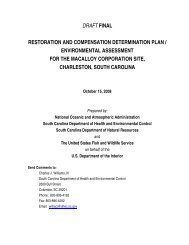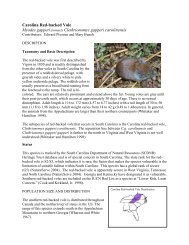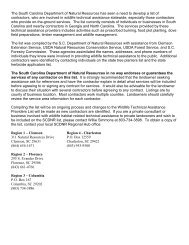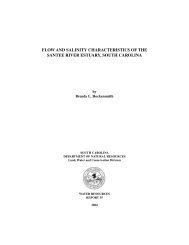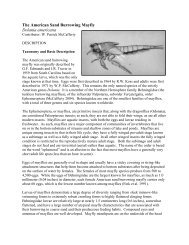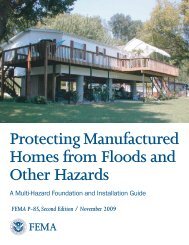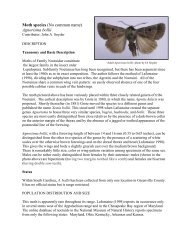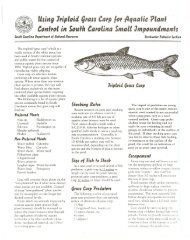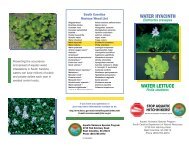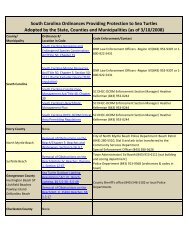ID Booklet -Illegal Aquatic Plants of South Carolina
ID Booklet -Illegal Aquatic Plants of South Carolina
ID Booklet -Illegal Aquatic Plants of South Carolina
Create successful ePaper yourself
Turn your PDF publications into a flip-book with our unique Google optimized e-Paper software.
<strong>Illegal</strong> <strong>Aquatic</strong><br />
<strong>Plants</strong> <strong>of</strong><br />
<strong>South</strong> <strong>Carolina</strong><br />
<strong>Aquatic</strong> Nuisance<br />
Species Program<br />
<strong>South</strong> <strong>Carolina</strong> Department<br />
<strong>of</strong> Natural Resources
<strong>Illegal</strong> <strong>Aquatic</strong> <strong>Plants</strong><br />
<strong>of</strong> <strong>South</strong> <strong>Carolina</strong><br />
Non-native plants are responsible for most aquatic weed problems<br />
in <strong>South</strong> <strong>Carolina</strong>. The lack <strong>of</strong> natural controls allows these plant<br />
species to thrive and develop large dense populations that impair the<br />
health and use <strong>of</strong> our public waterways. <strong>Aquatic</strong> weeds, such as hydrilla<br />
and water hyacinth, obstruct navigable waterways, restrict water flow,<br />
clog water intakes, degrade water quality, provide breeding habitat for<br />
mosquitoes and other pests, interfere with recreation, displace native<br />
plant species, and may upset the balance <strong>of</strong> desirable fish populations.<br />
Since 1981, over $18 million has been spent trying to control nuisance<br />
aquatic plant populations in public waters, with most <strong>of</strong> the funding<br />
used to control non-native species.<br />
Preventing the occurrence and spread <strong>of</strong> aquatic weed infestations<br />
in public waters can save millions <strong>of</strong> public and private dollars each<br />
year in avoided water impacts and control costs. Because prevention<br />
is so important, <strong>South</strong> <strong>Carolina</strong>, like several states, has adopted laws<br />
which prohibit the importation and distribution <strong>of</strong> specific exotic<br />
aquatic plant species known to cause problems.<br />
The <strong>South</strong> <strong>Carolina</strong> Noxious Weed Act provides the <strong>South</strong><br />
<strong>Carolina</strong> Department <strong>of</strong> Agriculture with far reaching powers to “seize,<br />
quarantine, treat, destroy, apply other remedial measures, to export,<br />
return to shipping point, or otherwise dispose <strong>of</strong> in such a manner as (it)<br />
deems appropriate, any noxious weed.” To further deter persons from<br />
spreading nuisance aquatic seeds the law includes fines not exceeding<br />
$500 and/or imprisonment not exceeding one year.<br />
The <strong>South</strong> <strong>Carolina</strong> Department <strong>of</strong> Natural Resources and the<br />
<strong>Aquatic</strong> Plant Management Council are working with Clemson<br />
University’s Department <strong>of</strong> Plant Industry and the Department <strong>of</strong><br />
Agriculture to improve the implementation <strong>of</strong> these laws as they relate<br />
to nuisance aquatic plants. Educating the public and the plant nursery<br />
industry about the law and the potential problems associated with<br />
certain aquatic plants is an important component <strong>of</strong> the prevention<br />
effort.<br />
The purpose <strong>of</strong> this booklet is to help owners and operators <strong>of</strong> plant<br />
nurseries and aquarium shops, as well as, the general public to easily<br />
identify illegal aquatic plant species, thereby reducing the risk <strong>of</strong> their<br />
importation and distribution in <strong>South</strong> <strong>Carolina</strong>.
Noxious Weed List<br />
for<br />
<strong>South</strong> <strong>Carolina</strong><br />
Alligatorweed<br />
Alternanthera philoxeroides<br />
Brazilian elodea<br />
Egeria densa<br />
Common reed<br />
Phragmites australis<br />
Eurasian watermilfoil<br />
Myriophyllum spicatum<br />
Giant salvinia<br />
Salvinia molesta, S. biloba<br />
S. herzogii, S. auriculata<br />
Hydrilla*<br />
Hydrilla verticillata<br />
Purple Loosestrife<br />
Lythrum salicaria<br />
Slender naiad<br />
Najas minor<br />
Water chestnut<br />
Trapa natans<br />
Water hyacinth<br />
Eichhornia crassipes<br />
Water Lettuce<br />
Pistia stratiotes<br />
Water primrose<br />
Ludwigia hexapetala<br />
African oxygen weed*<br />
Lagarosiphon major<br />
Ambulia*<br />
Limnophila sessiliflora<br />
Arrowhead*<br />
Sagittaria sagittifolia<br />
Arrow-leaved monochoria* Monochoria hastata<br />
Duck lettuce*<br />
Ottelia alismoides<br />
Exotic bur reed*<br />
Sparganium erectum<br />
Mediterranean clone <strong>of</strong> caulerpa* Caulerpa taxifolia<br />
Melaleuca*<br />
Melaleuca quinquenervia<br />
Miramar weed*<br />
Hygrophila polysperma<br />
Pickerel weed*<br />
Monochoria vaginalis<br />
Mosquito fern*<br />
Azolla pinnata<br />
Rooted water hyacinth*<br />
Eichhornia azurea<br />
Water spinach*<br />
Ipomoea aquatica<br />
Wetland nightshade*<br />
Solanum tampicense<br />
* also on Federal Noxious Weed List<br />
1
Alligatorweed<br />
(Alternanthera philoxeroides)<br />
Alligatorweed is an aggressive emergent perennial from <strong>South</strong><br />
America. Stems reach a length <strong>of</strong> 3 feet or more. Leaves are<br />
opposite, entire, and up to 4 inches long. It is distinguished by its<br />
small, white, clover-like flowers. Alligatorweed spreads rapidly by<br />
fragmentation.<br />
2<br />
Brazilian<br />
Elodea<br />
(Egeria densa)<br />
© Bio-Photo Services Inc.<br />
Egeria is a branched submersed perennial from <strong>South</strong> America.<br />
Leaves occur in whorls <strong>of</strong> 3-6 around a long stem and are up to 1<br />
inch long and 1/5 inch wide with finely toothed margins. Flowers<br />
are about 1/2 inch in diameter, white, and 3 petaled. Similar in<br />
appearance to hydrilla but is usually distinguished by its smooth<br />
texture and larger leaves and flowers. It is sometimes sold as<br />
“Anacharis.”
Common Reed<br />
(Phragmites australis)<br />
Phragmites is a perennial grass that reaches 10 feet in height. Leaves<br />
are two-ranked, flat, long-attenuate up to 1 1/2 feet long and 1/2 inch<br />
wide, blue-green in color with rough margins. The leafy stem is topped<br />
by a 1 foot long silvery brown silky panicle <strong>of</strong> flowers. Common reed<br />
reproduces and spreads readily by rhizomes.<br />
Eurasian<br />
Watermilfoil<br />
(Myriophyllum spicatum)<br />
This introduced species is a submersed perennial with distinct feathery<br />
leaves arranged in whorls <strong>of</strong> 4 around a long slender stem. Leaves are<br />
up to 1 inch long and usually dark green but <strong>of</strong>ten with a reddish tint.<br />
The flowering stem is very slender and up to 6 inches long with whorls<br />
<strong>of</strong> inconspicuous flowers. Eurasian watermilfoil reproduces by fragmentation.<br />
3
Giant Salvinia<br />
(Salvinia molesta)<br />
Giant salvinia is a small, free floating, introduced aquatic fern. It<br />
usually appears as branched stems with floating leaves in whorls <strong>of</strong><br />
3. Floating leaves are light to medium green, suborbicular, and 1/2 to<br />
1 inch long and wide. The upper surface is covered with dense, stiff<br />
white hairs with distinct “egg beater” shaped tips.<br />
Hydrilla<br />
(Hydrilla verticillata)<br />
© Bio-Photo Services Inc.<br />
Hydrilla is an introduced submersed perennial. Leaves are up to 2/3<br />
inch long with sharply toothed margins and occur in whorls <strong>of</strong> 3-8<br />
around a long thin stem. Sharp teeth located on the lower midrib<br />
<strong>of</strong> the leaves gives the plant a rough feel. Hydrilla exhibits multiple<br />
branching at a single node. Translucent white flowers are less than 1/4<br />
inch in diameter. It is sometimes sold as “Anacharis.”<br />
4
Purple Loosestrife<br />
(Lythrum salicaria)<br />
© Vermont Department <strong>of</strong> Environmental Conservation<br />
Purple loosestrife is an emergent perennial originally from Europe that<br />
grows to 6 feet with multiple woody stalks. Leaves are typically opposite,<br />
lance-shaped, and 3 to 4 inches long. It is distinguished by its long<br />
dense spike <strong>of</strong> bright pink/purple flowers at the top <strong>of</strong> the stems. Each<br />
plant can produce millions <strong>of</strong> seeds annually.<br />
Slender Naiad<br />
(Najas minor)<br />
© Bio-Photo Services Inc.<br />
Slender naiad is a submersed annual from Europe that grows to 4 feet<br />
in length. Leaves are opposite, very narrow with 7-15 marginal teeth<br />
and up to 1 1/2 inches long. The abundant stiff recurved leaves near<br />
the end <strong>of</strong> the branches give the plant a bushy appearance. Inconspicuous<br />
flowers and fruit are located in the leaf axils.<br />
5
Water Chestnut<br />
(Trapa natans)<br />
© Vermont Department <strong>of</strong> Environmental Conservation<br />
Water chestnut is an emersed or floating plant. The lower leaves are<br />
submersed, sessile, alternate, and cleft. The upper floating leaves are<br />
diamond shaped with distinct teeth along the leaf margins. The flower<br />
<strong>of</strong> water chestnut has 4 white petals with 4 green sepals. The fruit is a<br />
nut enclosed in a thorny calyx with 4 sharp spines.<br />
Water Hyacinth<br />
(Eichhornia crassipes)<br />
© Bio-Photo Services Inc.<br />
This free-floating plant from Brazil reaches up to 3 feet in height.<br />
Leaves are thick, leathery, and elliptic to ovate in shape and emerge<br />
from the plant base. The leaf stem is inflated and spongy to provide<br />
floatation. The flowering spike contains 5-20 very showy light purple<br />
flowers with a yellow spot. Roots are dark, fibrous, and feathery in<br />
appearance. This is a very popular water garden plant.<br />
6
Water Lettuce<br />
(Pistia stratiotes)<br />
Water lettuce is a free-floating, stoloniferous perennial from the tropical/subtropical<br />
regions <strong>of</strong> the world. Leaves are formed in rosettes,<br />
are densely pubescent, grayish to light green in color and up to 6 inches<br />
long. Leaf shape is ovate to obovate with a truncate apex. It reproduces<br />
vegetatively by forming new plants on stolons.<br />
Water Primrose<br />
(Ludwigia hexapetala)<br />
Water primrose is an emergent perennial that grows to 3 feet tall but<br />
stems may be many feet long when floating on the water. Leaves are<br />
alternate and variable in shape from suborbicular in early growth stages<br />
to lanceolate in the mature stage. Flowers are bright yellow and about<br />
1 inch in diameter with 5-6 sepals.<br />
7
Limnophila<br />
(Limnophila sessiliflora)<br />
© Dr. David Sutton, U. <strong>of</strong> Florida<br />
Limnophila is a perennial from <strong>South</strong>east Asia. Most <strong>of</strong> the plant is<br />
submersed, but a few inches <strong>of</strong> the stem and leaves can be emergent.<br />
Submersed leaves are up to 1 inch long, feathery, and in whorls about<br />
the stem, while emersed leaves are generally lance-shaped with irregular<br />
margins. Stems are up to 12 feet long. Single blue to lavender<br />
flowers occassionally occur on the emersed portion <strong>of</strong> the stem.<br />
Hygrophila<br />
(Hygrophila polysperma)<br />
© Bio-Photo Services Inc.<br />
Hygrophila is a prolific exotic originally from the East Indies. It is<br />
mostly submersed, but a small portion <strong>of</strong> the plant may extend above<br />
the water surface. Leaves are opposite, elliptic to oblong, entire, and<br />
1 1/2 inch long and 1/2 inch wide. Stems are square and grow up to 6<br />
feet. Flowers are white to bluish-white and located in the axils <strong>of</strong> upper<br />
leaves.<br />
8
STOP AQUATIC<br />
HITCHHIKERS!<br />
Prevent the transport <strong>of</strong> nuisance species.<br />
Clean all recreational equipment!<br />
Proud partners with:<br />
www.ProtectYourWaters.net www.habitatitude.net www.dnr.state.sc.us<br />
To report the occurance <strong>of</strong> illegal aquatic plants or if you have<br />
questions contact us at:<br />
<strong>Aquatic</strong> Nuisance Species Program<br />
<strong>South</strong> <strong>Carolina</strong> Department <strong>of</strong> Natural Resources<br />
2730 Fish Hatchery Road<br />
West Columbia SC 29172<br />
pagec@dnr.sc.gov<br />
Phone - (803) 755-2836 • Fax - (803) 755-0617<br />
or visit<br />
www.dnr.state.sc.us/water/envaff/aquatic/index.html<br />
The <strong>South</strong> <strong>Carolina</strong> Department <strong>of</strong> Natural Resources prohibits discrimination on the basis <strong>of</strong> race,<br />
gender, color, national origin, disability, age or religion. Direct all inquiries to the Office <strong>of</strong> Human<br />
Resources, PO box 167, Columbia, SC 29202.<br />
Total copies<br />
Printed on Recycled paper<br />
Total cost<br />
Cost per copy



